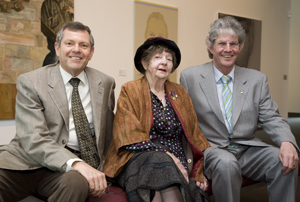Art and Architecture, by Philip Bacon, art dealer and philanthropist

Ars Longa, Vita Brevis. If indeed life is short and art long, as Hippocrates so famously states in his aphorism of 400BC, then John Hay’s most long-lived achievement may very well be the stunning James and Mary Emelia Mayne Centre, conjured up from the ageing and redundant Mayne Hall just three years ago.
In the overall scheme of the huge building projects undertaken during the Vice-Chancellor’s tenure, this new home for the University Art Museum could perhaps be one of the smaller; yet to my mind it ranks amongst his most important achievements. From the body of the old hall, and fighting those who wanted things to stay as they were, John wrought a magic transformation.
The use of natural light is a triumph in this space. Natural light is sometimes seen as the enemy when architects work on art galleries, but not in this case. Visitors move through the gallery in a naturally intuitive way, able to appreciate the “bones” of the old building, while enjoying the dramatic changes.
This vision was only realised through single-minded persistence, not just with the planning, but also with fundraising. John’s friend Chuck Feeney answered the call, contributing $5 million.
John and Chuck also decided to create a National Collection of Artist’s Self-Portraits, and this has begun to achieve a real and unique status amongst art museums across Australia.
Self-portraiture is an in-turned art, and there is something strange lurking on the edge between the seer and the seen. The attempt to confront death may be soberingly honest, but it causes in itself a kind of consolation.
“The work lives” (even when the artist doesn’t) and this is always the hope implicit in any act of making. This too will be John’s reward. He has “made” so many works of art, of architecture, and of creative thought.
I began with only the first four words of Hippocrates’ aphorism. It says in full: “Life is short; and art long; the crisis fleeting; experience perilous, and decision difficult. The physician must not only be prepared to do what is right himself, but also to make the patient, the attendants and externals cooperate.”
This surely is what John Hay has done so very well.
